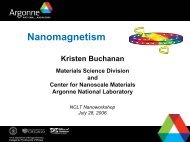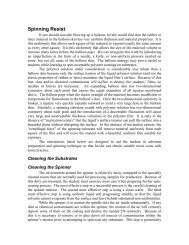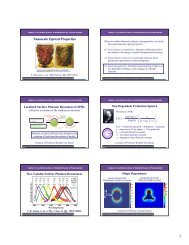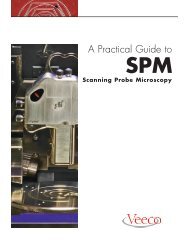Presentation for instructor (PDF)
Presentation for instructor (PDF)
Presentation for instructor (PDF)
You also want an ePaper? Increase the reach of your titles
YUMPU automatically turns print PDFs into web optimized ePapers that Google loves.
NANO-THERMODYNAMICS<br />
Ryan Ginder<br />
Hsaio-Yu Ko<br />
Tejas Shastry
<strong>Presentation</strong> Goals<br />
Explain why nanotechnology is important<br />
Define and explain nanoscale, surface area to<br />
volume ratio, and melting point depression<br />
Demonstrate learning module’s ability to simulate<br />
and elaborate the nanoscale concepts
Why is nanotechnology important?<br />
Properties and behavior change<br />
Applications<br />
• Carbon nanotubes<br />
• Nanoparticles <strong>for</strong> drug delivery<br />
• Nanomaterials<br />
New Industries and oppertunities
Carbon NanoTube
What is “nano”?<br />
Exact scale example<br />
Relative scale example<br />
Dimension limit <strong>for</strong> nanoscience<br />
Upper bound - 100nm <strong>for</strong> effects to be seen<br />
Lower bound – 1nm to avoid atomic effects
Scale of Metric System
Size/Scale
Surface Area/Volume Ratio<br />
The SA/V ratio is the surface area of a shape<br />
divided by its volume.<br />
Explain the behavior of the SA/V ratio as the size of<br />
an object changes.<br />
Explain how the SA/V ratio is used to define the<br />
nanoscale region as 1-100nm.
SA/V Ratio Vs. Edge Length
Effects of SA/V ratio<br />
More surface <strong>for</strong> interaction<br />
More surface energy than bulk material<br />
Melting point depression
Melting Point Depression<br />
When heating a solid to a certain point, there<br />
will be enough energy to break the bonds<br />
holding the material together<br />
Since the atoms on the surface are bonded to<br />
fewer atoms, they are easier to pull apart<br />
At the nanoscale, SA/V increases, and thus<br />
melting requires less energy<br />
Just as SA/V, 100nm is the critical point
Melting Point Depression Formula<br />
ΔT-change in melting temperature<br />
γ-surface energy<br />
Vs-molar volume<br />
Tm-melting temperature in normal scale (r=∞)<br />
ΔHm-enthalpy of melting<br />
r-the radius of the pieces that a material is sliced into
Melting Point Depression of Gold<br />
Change in Melting Temperature <strong>for</strong> Au Particles<br />
0<br />
0 1E-07<br />
-50<br />
Delta T (K)<br />
-100<br />
-150<br />
γ = 0.132 T/m 2<br />
ΔHm = 12,600 J /mole<br />
Tm = 1336K (at r= ∞)<br />
Vs = 10.2E-6 m 3 /mol<br />
-200<br />
-250<br />
-300<br />
Radius (m)
Learning Module Goals<br />
Introduce the importance of nanotechnology<br />
Describe the changes that occur at the nanoscale<br />
level<br />
Explain size and scale from 1 meter to 1 nanometer<br />
Demonstrate the mechanism behind the increase of<br />
surface area to volume ratio with decreasing particle<br />
size<br />
Demonstrate the mechanism behind melting point<br />
depression with decreasing particle size
How Software Works<br />
What is a nanometer?: This section features a<br />
step-by-step animation going from the macroscopic<br />
to nanoscale world.<br />
Surface Area to Volume Ratio: Users derive the<br />
surface area/volume relationship by observing the<br />
change in surface area as they decrease particle size<br />
Melting Point Depression: Users observe how the<br />
melting point of gold changes as they decrease the<br />
particle size.
Advantages of Software<br />
Sections are very visual when presenting the<br />
concepts<br />
Use of the software is self-explanatory<br />
Helpful and concise explanations are provided <strong>for</strong><br />
each of the concepts<br />
Software is flash-based, so it can be easily<br />
accessed from any web browser
References<br />
Case Western Reserve University. Nanopedia: The Nanoscale. 15 March 2009<br />
.<br />
ChemED Collaborative. The International System of Units (SI). 5 December 2008. 15 March<br />
2009 .<br />
Dorling Kindersley. Matter: Gold Atom. 2009. 15 March 2009 .<br />
Feng Shui Supply. 3" Gold Bar. 2009. 15 March 2009 .<br />
Northwestern University. Size Matters! 2005. 15 March 2009<br />
.<br />
Owen, James. Nanotubes and Fullerenes <strong>for</strong> Quantum Computing. 15 March 2009<br />
.<br />
Ströck, Michael. Wikimedia Commons: Types of Carbon Nanotubes. 24 January 2009. 15<br />
March 2009 .<br />
University of Wisconsin at Madison. Making and Conjugating Colloidal Metals. 15 March<br />
2009<br />
.
















